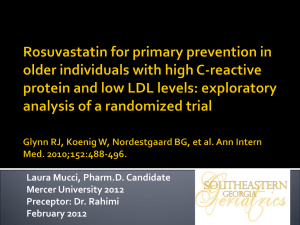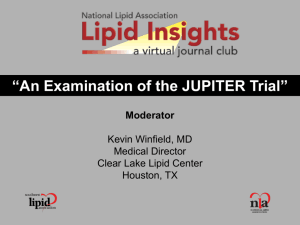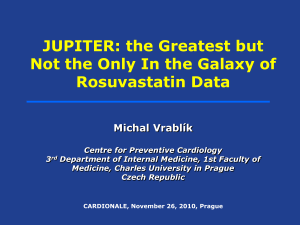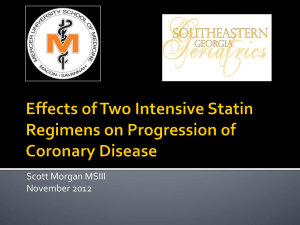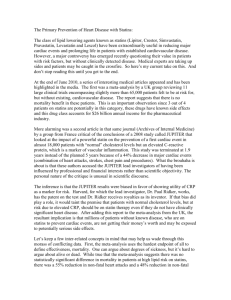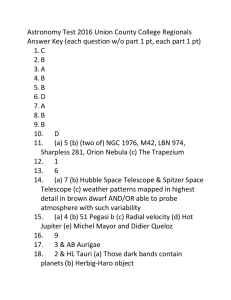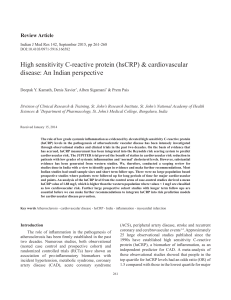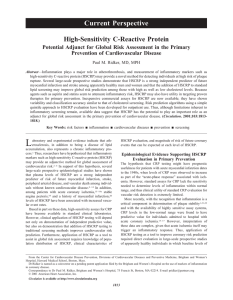Placebo - WikiDoc
advertisement
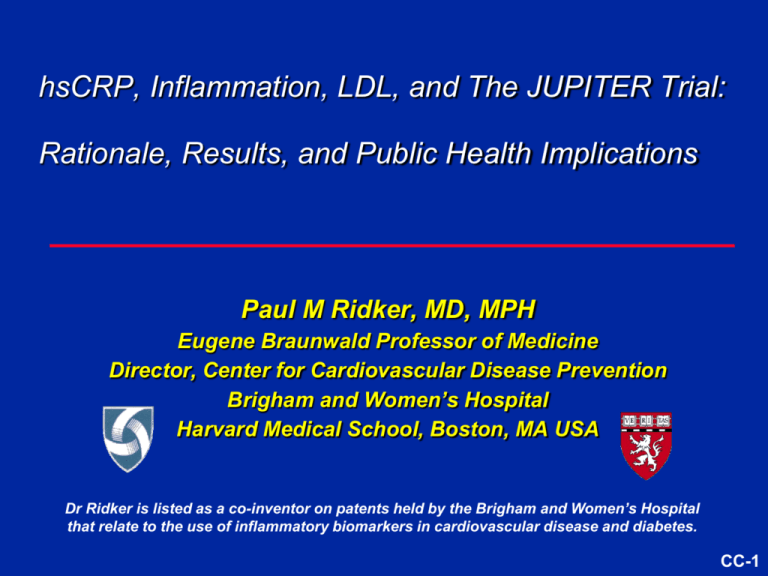
hsCRP, Inflammation, LDL, and The JUPITER Trial: Rationale, Results, and Public Health Implications Paul M Ridker, MD, MPH Eugene Braunwald Professor of Medicine Director, Center for Cardiovascular Disease Prevention Brigham and Women’s Hospital Harvard Medical School, Boston, MA USA Dr Ridker is listed as a co-inventor on patents held by the Brigham and Women’s Hospital that relate to the use of inflammatory biomarkers in cardiovascular disease and diabetes. CC-1 Dr Ridker has received investigator-initiated research support from the NHLBI, NCI, American Heart Association, Donald W Reynolds Foundation, Leduc Foundation, Doris Duke Charitable Foundation, AstraZeneca, Novartis, and SanofiAventis. Dr Ridker has served as a consultant to Seimens, AstraZeneca, Vascular Biogenics, Merck Schering Plough, and Novartis. Dr Ridker is listed as a co-inventor on patents held by the Brigham and Women’s Hospital that relate to the use of inflammatory biomarkers in cardiovascular disease and diabetes that have been licensed to Seimens and AstraZeneca. CC-2 LDLC Levels in 136,905 Patients Hospitalized With CAD: 2000- 2006 LDLC (mg/dL) < 130 130-160 > 160 Sachdeva et al, Am Heart J 2009;157:111-7.e2. CC-3 hsCRP and Risk of Future MI and CVA in Apparently Healthy Men P Trend <0.001 P Trend <0.01 Relative Risk of Stroke Relative Risk of MI 3 2 1 0 1 2 3 4 Quartile of hs-CRP Ridker et al, N Engl J Med 1997;336:973–979. 2 1 0 1 2 3 Quartile of hs-CRP 4 Fully Adjusted Relative Risk hsCRP Adds Prognostic Information Beyond Traditional Risk Factors in All Major Cohorts Evaluated 3 3 3 3 3 3 3 2 2 2 2 2 2 2 1 1 1 1 1 1 1 0 0 0 0 0 0 0 WHS 2000 PHS 1997 UK 2000 MONICA 2004 ARIC 2004 NHS 2004 Iceland 2004 3 3 3 3 3 3 3 2 2 2 2 2 2 2 1 1 1 1 1 1 1 0 0 0 0 0 0 0 HPFUS 2004 Ridker P. JACC 2007; 49: 2129-2138 EPIC-N 2005 Strong 2005 < 1 mg/L Kuopio 2005 CHS 2005 1 to 3 mg/L PIMA 2005 FHS 2008 > 3 mg/L CC-6 C-reactive protein concentration and risk of cardiovascular events : 2010 Coronary Heart Disease 3.0 2.5 2.0 1.5 Risk ratio (95% CI) 1.0 Ischaemic Stroke 3.0 2.5 2.0 1.5 1.0 All Vascular Deaths 3.0 2.5 2.0 1.5 1.0 0.5 1.0 2.0 4.0 8.0 0.5 1.0 2.0 4.0 hsCRP concentration (mg/L) Age, gender adjusted Emerging Risk Factor Collaborators, Lancet Jan 2010 Fully adjusted 8.0 C-reactive protein concentration and risk of cardiovascular events : 2010 Direct comparison of hsCRP, systolic blood pressure, total cholesterol, and non-HDLC Risk Ratio (95%CI) hsCRP 1.37 (1.27-1.48) Systolic BP 1.35 (1.25-1.45) Total cholesterol 1.16 (1.06-1.28) Non-HDLC 1.28 (1.16-1.40) 0.5 1.0 1.2 1.4 1.8 Risk Ratio (95%CI) per 1-SD higher usual values Adjusted for age, gender, smoking, diabetes, BMI, BP, triglycerides, alcohol, lipid levels, and hsCRP Emerging Risk Factor Collaborators, Lancet Jan 2010 Inflammation, hsCRP, and Vascular Prevention FDA Perspective Is there evidence that individuals with elevated levels of the inflammatory biomarker hsCRP are at increased vascular risk? Is there evidence that individuals identified at increased risk due to inflammation benefit from a therapy they otherwise would not have received? CC-9 Inflammation, Statin Therapy, and hsCRP: Initial Observations P Trend = 0.005 -21.6% (P=0.004) 0.25 Median hs-CRP (mg/dL) Relative Risk 3 2 1 0 Placebo 0.24 0.23 0.22 0.21 Pravastatin 0.20 0.19 0.18 Pravastatin Placebo Pravastatin Placebo Baseline 5 Years Inflammation Absent Inflammation Present Ridker et al, Circulation. 1998;98:839–844. Ridker et al, Circulation. 1999;100:230-235. CC-10 Primary Prevention : Whom Should We Treat ? Probability of Event-free Survival 1.00 hsCRP < 2, LDL < 130 0.99 hsCRP < 2, LDL > 130 0.98 hsCRP > 2, LDL < 130 0.97 hsCRP > 2, LDL > 130 0.96 0.00 0 2 4 6 8 Years of Follow-up Ridker et al, N Engl J Med. 2002;347:1557-1565. CC-11 hsCRP as a Method to Target Statin Therapy in Primary Prevention: AFCAPS/TexCAPS Study Group Statin Placebo NNT low LDLC / low hsCRP 0.025 0.022 ---- low LDLC / high hsCRP 0.029 0.051 48 high LDLC / low hsCRP 0.020 0.050 33 high LDLC / high hsCRP 0.038 0.055 58 Median LDLC = 150 mg/dL Median CRP = 2 mg/L Ridker et al, N Engl J Med 2001;344:1959-65 “These hypothesis generating clinical studies, together with the recognition that… atherosclerosis is in part an inflammatory disease and that the lowering of lipid levels may represent an anti-inflammatory process, appear to provide a rationale for considering wider use of statins than is typically achieved in current practice”. “Nonetheless, despite large differences in the number needed to treat… the absolute number of events that occurred in each of the four [AFCAPS/TexCAPS] subgroups was small… Thus, randomized trials of statin therapy among persons without overt hyperlipidemia but with evidence of systemic inflammation are needed in order to test these hypotheses directly.” Ridker et al, N Engl J Med 2001;344:1959-65 JUPITER: Trial design Multi-National Randomized Double Blind Placebo Controlled Trial of Rosuvastatin in the Prevention of Cardiovascular Events Among Individuals With Low LDL and Elevated hsCRP MI Rosuvastatin 20 mg (N=8901) No Prior CVD or DM Men ≥50, Women ≥60 LDL <130 mg/dL hsCRP ≥2 mg/L Stroke Unstable 4-week run-in Placebo (N=8901) Angina CVD Death CABG/PTCA Argentina, Belgium, Brazil, Bulgaria, Canada, Chile, Colombia, Costa Rica, Denmark, El Salvador, Estonia, Germany, Israel, Mexico, Netherlands, Norway, Panama, Poland, Romania, Russia, South Africa, Switzerland, United Kingdom, Uruguay, United States, Venezuela JH-14 JUPITER: Primary Objectives Justification for the Use of statins in Prevention: an Intervention Trial Evaluating Rosuvastatin To investigate whether rosuvastatin 20 mg compared to placebo would decrease the rate of first major cardiovascular events among apparently healthy men and women with LDL < 130 mg/dL (3.36 mmol/L) who are nonetheless at increased vascular risk on the basis of an enhanced inflammatory response, as determined by hsCRP ≥ 2 mg/L. To enroll large numbers of women and individuals of Black or Hispanic ethnicity, groups for whom little data on primary prevention with statin therapy exists. JH-15 JUPITER: Why Consider Statins for Low LDL, high hsCRP Patients? AFCAPS/TexCAPS Low LDL Subgroups Low LDL, Low hsCRP Low LDL, High hsCRP 0.5 1.0 2.0 RR Statin Effective Statin Not Effective While intriguing and of potential public health importance, the observation in AFCAPS/TexCAPS that statin therapy might be effective among those with elevated hsCRP but low cholesterol was made on a post hoc basis. Thus, a large-scale randomized trial of statin therapy was needed to directly test this hypotheses. Ridker et al New Engl J Med 2001;344:1959-65. JH-16 JUPITER: Trial Structure Independent Steering Committee: – P Ridker (Chair), F Fonseca, J Genest, A Gotto, J Kastelein, W Koenig, P Libby, A Lorenzatti, B Nordestgaard, J Shepherd, J Willerson Independent Academic Clinical Coordinating Center: – P Ridker, E Danielson, R Glynn, J MacFadyen, S Mora (Boston) Independent Academic Study Statistician: – R Glynn (Boston) Independent Data Monitoring Board: – R Collins (Chair), K Bailey, B Gersh, G Lamas, S Smith, D Vaughan Independent Academic Clinical Endpoint Committee: – K Mahaffey (Chair), P Brown,D Montgomery, M Wilson, F Wood (Durham) NEJM 2008; 359: 2195-2207 JH-17 JUPITER: 17,802 Patients, 1,315 Sites, 26 Countries Randomizations (% Total.) 25 Total Randomized = 17,802 4021 20 2873 15 2497 2020 10 804 5 987 741 14 15 32 327 336 345 197 202 204 209 222 253 270 273 162 143 83 85 487 0 JH-18 JUPITER: Inclusion/Exclusion Criteria, Study Flow 89,890 screened Inclusion criteria Men >50 years Women >60 years No CVD, No DM LDL <130 mg/dL hsCRP >2 mg/dL 4 week Placebo Run-in 17,802 Randomized 8901 assigned to Rosuvastatin 20 mg Reason for Exclusion LDL>130 mg/dL hsCRP<2 mg/L Withdrew consent Diabetes Hypothyroid Liver disease TG >600 mg/dL Age out of range Current use of HRT Cancer Poor compliance/Other % 52 36 5 1 <1 <1 <1 <1 <1 <1 <1 8901 assigned to Placebo 8,169 fully complete 8,857 Vital status known 8,155 fully complete 8,864 Vital status known 19 % d/c study med 7.8 % withdrew 2.0 % non-trial statin 22 % d/c study med 8.0 % withdrew 4.4 % non-trial statin 8,901 Included in Efficacy 8,901 Included in Efficacy and Safety Analyses and Safety Analyses JH-19 JUPITER: Pre-specified Monitoring and Stopping Guidelines JUPITER was an event-driven trial designed to continue until accrual of 520 confirmed primary endpoints to attain 90% power to detect a 25% reduction in the rate of the primary endpoint The monitoring plan specified interim efficacy analyses with O’Brien-Fleming stopping boundaries determined by the LanDeMets approach upon attainment of 37.5% and 75% of the targeted numbers of endpoints The IDMB charter specified that an early stopping recommendation required proof beyond reasonable doubt that for all, or some specific types of patients, prolonged use of rosuvastatin is clearly indicated or clearly contraindicated based on the interim analyses or other sources which might reasonably be expected to influence clinicians’ management decisions for subjects in the study JH-20 JUPITER: Statistical Analysis Plan Primary efficacy analyses counted all events diagnosed by March 30, 2008 according to the intention to treat principle. Safety analyses included events through the closeout visit, with the last closeout visit on August 20, 2008 Statistical significance determined by a likelihood ratio test of a proportional hazards model including only the treatment assignment. Validity of the proportional hazards assumption was evaluated graphically and by a likelihood ratio test of interaction between treatment effect and study time Possible heterogeneity in the relative treatment effect across subgroups evaluated through likelihood ratio tests of interaction terms in a proportional hazards model Estimates of net clinical benefits were based on the number needed to treat (NNT) over 4 years and projected to 5 years by the method of Altman and Andersen JH-21 JUPITER: Baseline Blood Levels (Median, Interquartile Range) Rosuvastatin (N=8901) Placebo (n=8901) 4.2 (2.8 – 7.1) 4.3 (2.8 – 7.2) hsCRP mg/L LDL mg/dL mmol/L 108 (94 – 119) 2.8 (2.43 – 3.08) 108 (94 – 119) 2.8 (2.43 – 3.08) HDL mg/dL mmol/L 49 (40 – 60) 1.27 (1.03 – 1.55) 49 (40 – 60) 1.27 (1.03 – 1.55) Triglycerides mg/dL mmol/L 118 (85 – 169) 1.33 (0.96 –1.91) 118 (86 – 169) 1.33 (0.97 – 1.91) Total Cholesterol mg/dL mmol/L 186 (168 – 200) 4.82 (4.35 – 5.18) 185 (169 – 199) 4.79 (4.38 – 5.15) Glucose mg/dL mmol/L 94 (87 – 102) 5.22 (4.83 – 5.66) 94 (88 – 102) 5.22 (4.88 – 5.66) HbA1c % 5.7 (5.4 – 5.9) 5.7 (5.5 – 5.9) All values are median (interquartile range) [Mean LDL = 104 mg/dL (2.69 mmol/L)] JH-22 Comparison of the JUPITER Trial Population to Previous Statin Trials of Primary Prevention JUPITER Sample size (n) WOSCOPS AFCAPS 17,802 6,595 Women (n) 6,801 0 997 Non-Caucasian (n) 5,118 0 350 Duration (yrs) 1.9 (max 5) 4.9 5.2 Diabetes (%) 0 1 6 Baseline LDL-C (mg/dL) 104 192 150 Baseline HDL-C (mg/dL) 49 44 36-40 Baseline TG (mg/dL) 118 164 158 Baseline hsCRP (mg/L) >2 NA NA Rosuvastatin 20 mg Pravastatin 40 mg Lovastatin 10-40 mg Intervention 6,605 JUPITER Trial Study Group, Am J Cardiol 2007; 100: 1659-1664. JH-23 JUPITER: Primary Endpoint 9 Rosuvastatin Cumulative incidence, % 8 Placebo Number of events 142 (1.6%) 252 (2.8%) 7 44% 6 HR 0.56 (95% CI 0.46-0.69) P=<0.00001 5 4 3 2 1 0 0 1 2 3 4 Years Number at risk Rosuvastatin 8901 8412 3892 1352 543 156 Placebo 8901 8353 3872 1333 534 173 JH-24 JUPITER: Primary Endpoint by Time Since Randomization Time since randomization P value 6 months 0.029 12 months <0.001 18 months <0.001 2 years <0.001 2.5 years <0.001 3 years <0.001 0.1 1 Hazard ratio (95% CI) JH-25 JUPITER: Fatal or Nonfatal Myocardial Infarction 3 Rosuvastatin Number of events 31 Placebo 68 Cumulative Incidence 2.5 2 HR 0.46 (95% CI 0.30-0.70) P<0.0002 1.5 - 54 % 1 0.5 0 1 2 3 4 Follow-up Years JH-26 JUPITER: Fatal or Nonfatal Stroke Rosuvastatin Number of events 33 3 Placebo 64 Cumulative Incidence, % 2.5 HR 0.52 (95% CI 0.34-0.79) P=0.002 2 1.5 - 48 % 1 0.5 0 1 2 3 4 Follow-up Years JH-27 JUPITER: Bypass Surgery or PTCA / Hospitalization for UA Rosuvastatin 6 Placebo Number of events 76 143 Cumulative Incidence, % 5 4 HR 0.53 (95% CI 0.40-0.70) P<0.00001 - 47 % 3 2 1 0 1 2 3 4 Follow-up Years Number at Risk Rosuvastatin Placebo 8,901 8,901 8,640 8,641 8,426 8,390 6,550 6,542 3,905 3,895 1,966 1,977 1,359 1,346 989 963 547 538 158 176 JH-28 JUPITER: Primary Endpoint – Subgroup Analysis I N Men Women P for Interaction 11,001 6,801 0.80 Age ≤ 65 Age > 65 8,541 9,261 0.32 Smoker Non-Smoker 2,820 14,975 0.63 Caucasian Non-Caucasian 12,683 5,117 0.57 USA/Canada Rest of World 6,041 11,761 0.51 Hypertension No Hypertension 10,208 7,586 0.53 All Participants 17,802 0.25 0.5 Rosuvastatin Superior 1.0 2.0 Rosuvastatin Inferior 4.0 JH-29 JUPITER: Primary Endpoint – Subgroup Analysis II N Family HX of CHD No Family HX of CHD P for Interaction 2,045 15,684 0.07 BMI < 25 kg/m BMI 25-29.9 kg/m 2 BMI ≥30 kg/m2 4,073 7,009 6,675 0.70 Metabolic Syndrome No Metabolic Syndrome 7,375 10,296 0.14 Framingham Risk ≤ 10% Framingham Risk > 10% 8,882 8,895 0.99 All Participants 17,802 2 0.25 0.5 Rosuvastatin Superior 1.0 2.0 4.0 Rosuvastatin Inferior JH-30 JUPITER: Primary Endpoint By Ethnicity Caucasian (N = 12,683) 0.10 HR 0.55 (95% CI 0.43-0.69) P < 0.0001 HR 0.63 (95% CI 0.41-0.98) P = 0.04 0.08 Placebo 0.02 0.04 0.06 Placebo Rosuvastatin Rosuvastatin 0.00 Cumulative Incidence Black, Hispanic, Other (N = 5,019) 0 1 2 3 Follow-up (years) 4 0 1 2 3 4 Follow-up (years) JH-31 Cumulative Incidence, % JUPITER: Death from Any Cause 7 Rosuvastatin 6 Number of events 198 Placebo 247 - 20 % 5 HR 0.80 (95% CI 0.67−0.97) P=0.021 4 3 2 1 0 0 1 2 3 4 Years Number at risk Rosuvastatin 8901 8787 4313 1601 682 Placebo 8782 4323 1613 683 8901 6 JH-32 JUPITER: Individual components of the primary endpoint Endpoint Rosuvastatin Placebo HR 95%CI P Primary Endpoint* 142 252 0.56 0.46-0.69 <0.00001 Non-fatal MI Any MI 22 31 62 68 0.35 0.46 0.22-0.58 0.30-0.70 <0.00001 <0.0002 Non-fatal Stroke Any Stroke 30 33 58 64 0.52 0.52 0.33-0.80 0.34-0.79 0.003 0.002 Revascularization or Unstable Angina 76 143 0.53 0.40-0.70 <0.00001 MI, Stroke, CV Death 83 158 0.52 0.40-0.68 <0.00001 Adjudicated CV Death 35 44 0.80 0.51-1.24 0.32 Total Mortality 198 247 0.80 0.67-0.97 0.02 *Nonfatal MI, nonfatal stroke, revascularization, unstable angina, CV death NEJM 2008;359:2195-2207 JH-33 JUPITER: US/Canada vs non-US/Canada Region Rosuvastatin Placebo HR (95%CI) P value Primary Endpoint USA/Canada 81 (0.97) Non-US/Canada 61 (0.60) 136 (1.62) 115 (1.14) 0.60 (0.46-0.79) 0.52 (0.38-0.71) <0.001 <0.001 MI, CVA, CV Death USA/Canada 40 (0.48) Non-US/Canada 43 (0.42) 75 (0.88) 82 (0.81) 0.54 (0.37-0.79) 0.52 (0.36-0.75) 0.001 <0.001 MI, CVA, Any Death USA/Canada 100 (1.19) Non-US/Canada 139 (1.36) 148 (1.74) 205 (2.03) 0.68 (0.53-0.88) 0.67 (0.54-0.83) 0.003 <0.001 JH-34 JUPITER: Venous Thromboembolism Placebo 46 1 HR 0.57 (95% CI 0.35-0.91) P=0.018 0.5 - 43 % 0 Cumulative incidence, % 1.5 Rosuvastatin Number of events 26 0 1 2 3 5 6 Years Number at Risk Rosuvastatin 8,901 Placebo 8,901 4 8,648 8,652 8,447 8,417 6,575 6,574 3,927 3,943 1,986 2,012 1,376 1,381 1,003 993 548 556 161 182 Clear clinical benefit for VTE/PE in the absence of any bleeding hazard (hemorrhagic events : rosuvastatin 258, placebo 275, P=0.45) JH-35 JUPITER: Conclusions – Primary Endpoint Among apparently healthy men and women with elevated hsCRP but low LDL-C, rosuvastatin reduced major cardiovascular events by 44% Benefits of rosuvastatin were consistent regardless of age, sex, region or ethnicity Despite evaluating a population with lipid levels widely considered to be “optimal” in almost all current prevention algorithms, the relative benefit observed in JUPITER was greater than in almost all prior statin trials Rates of hospitalization and revascularization were reduced by 47 percent within a two-year period suggesting that the screening and treatment strategy tested in JUPITER is likely to be cost-effective, benefiting both patients and payers. JH-36 JUPITER: Number Needed to Treat (5 year) Endpoint All FRS≤10 FRS>10 Primary Endpoint 25 47 17 Primary Endpoint, Mortality 20 34 14 MI, Stroke, CABG/PTCA, Death 20 37 14 MI, Stroke, Death 29 60 20 Benchmarks: Statins for hyperlipidemia Diuretics Beta-blockers Aspirin Men Aspirin Women 5-year 5-year 5-year 5-year 5-year NNT NNT NNT NNT NNT 40-60 80-100 120-160 220-270 280-330 Ridker et al. Circulation CV Qual Outcomes 2009;2: 616-23. JH-37 2009 Canadian Cardiovascular Society (CCS) Guidelines for the Diagnosis and Treatment of Dyslipidemia and Prevention of Cardiovascular Disease in the Adult Primary Goal: LDLC High CAD, CVA, PVD Most pts with Diabetes FRS >20% RRS >20% <2 mmol/L or 50% reduction Class I Level A Moderate FRS 10-19% RRS 10-19% LDL >3.5 mmol/L TC/HDLC >5.0 hsCRP >2 in men >50 yr women >60 yr <2 mmol/L or 50% reduction Class IIA Level A Low FRS <10% <5 mmol/L Class IIA Level A Secondary Targets TC/HDLC <4, non HDLC <3.5 mol/L hsCRP <2 mg/L, TG <1.7 mol/L, ApoB/A <0.8 JH-38 JUPITER: Public Health Implications: Primary Endpoint at “Intermediate Risk” FRS (%) 5–10% (N=6091) 10–20% (N=7340) Rosuvastatin Placebo HR 95% CI 32 (0.50) 59 (0.92) 0.55 (0.36-0.84) 74 (0.95) 145 (1.84) 0.51 (0.39-0.68) None of these patients are currently recommended to receive statin therapy because they have Framingham 10-year risk <20% AND LDL-C levels below the treatment target (ie < 130 mg/dL). All have hsCRP > 2 mg/L. JH-39 Clinical Implications of the JUPITER Trial: Atherosclerotic Risk in Communities (ARIC) Men > 50, Women > 60, No Prior CVD, No JUPITER Exclusion LDL < 130 CRP < 2 LDL > 130 CRP < 2 LDL < 130 CRP > 2 LDL > 130 CRP > 2 N 1614 1132 1621 1146 LDL (mg/dL) 103 155 101 156 FRS (%) 5.0 6.3 4.7 7.1 CRP (mg/L) 0.9 1.0 4.7 4.4 CV Event Rate/100py 0.95 1.22 1.57 2.19 Wang et al, J Am Coll Cardiol 2009;54:2388–95) Clinical Relevance of hsCRP in the CORONA Trial McMurray JJV, et al. Circulation 2009;2188-2196. Questions for Discussion What is the status of surrogate endpoints in the regulatory approval process? If an endpoint is felt to be a “marker” of disease activity rather than a surrogate of disease activity (lies in the causal pathway), is lowering of the “marker” sufficient for approval? Should lipid-lowering agents be approved for clinical use based upon surrogate endpoints like CRP, restenosis, QT interval etc.? Do you see regulatory pathways built around “niche” markets in the future rather than around “all comers”? How do you address concerns such as expanded use of the drug in larger populations outside of the subgroup where it was evaluated? How big will future trials be? JH-42 Questions for Discussion If “hard” clinical endpoints are required, what are the most appropriate ones? What is the appropriate duration of follow-up? What RRR can we expect? All Cause Death? CV death? Ischemic stroke, all stroke, hemg stroke MI: Use of universal definition of MI to understand peri-procedural vs spontaneous MI vs demand etc.)? Size of MI? Recurrent hospitalization vs recurrent hospitalization requiring revascularization As part of an “adaptive” trial design, could phase II surrogate endpoint data be included in the dataset for a pivotal trial? Is there a role for Bayesian statistics and design in the future? JH-43 Questions for Discussion What is the interplay between AHA / ACC guidelines and the regulatory approval process? Must new drugs be studied on top of drugs that are already recommended in the ACC/ AHA guidelines? If so, are we in a position where new drugs must add to existing ones rather than replace them? Can trials utilize protocols that do not comply with the AHA / ACC guidelines? JH-44 Questions for Discussion What is the proper role of the ARO and CRO? Should they be competing or should they be complimentary? How do they most effectively partner? JH-45
